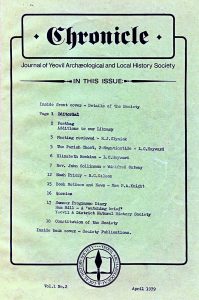1979-Apr-pg05-06_The Parish Chest – 2. Rogationtide
This article came from the Chronicle published April 1979. Pages 4 and 6
The Parish Chest – 2. Rogationtide
Author: L.C.Hayward
Under that holy oak or gospel tree
Where, though thou seelst not,
Thou gayest think upon
Me, when thou yearly go’st procession.
Herrick: Hesperides – To Anthea
The churchwardens’ accounts for 1457/8 mention a payment of ’15d for 2½ yards of linen cloth for two banners of the Church to be carried round the fields, 7d for dyeing and making the banners, and 2½d for 7 wooden rods for carrying the banners in procession’. These items in the accounts refer to the annual ceremony of blessing the crops which took place at Rogationtide just before Ascension Day. Priests and choirboys led a procession, round the fields, sometimes halting at a holy tree’ where the Gospel for the day was read. This custom may well be linked with the Roman Ambarvalia (29th May) when peasants in the fields made offerings to the Godess Ceres in the hope of a good harvest, and no doubt its pagan origin partly explains the suppression of this ceremony by the Reformers in 1547.
Linked with this custom at Rogationtide was the perambulation of the parish boundaries, a necessary means of preserving such knowledge before the days of large-scale maps. Disputes often arose about tithes, the liabilities of hamlets like Yeovil Marsh for repairing the church, or about rights of baptism and burial: ‘beating the bounds’ afforded one way of recording the evidence on which decisions could be based. This, too, was forbidden at the Reformation, but practical considerations prompted Elizabeth I to revive the custom: ‘the curate is to admonish the people to give thanks to God at convenient places’, and Psalms 103 and 104 were to be recited, together with such sentences as ‘Cursed is he that removeth his neighbour’s landmark’. (N.E.B. Deut.XXVII,v.17)
No payments in connection with the perambulation occur in the surviving Elizabethan accounts, but they regularly appear in the seventeenth and eighteenth centuries. The procession took place on three successive days in the Spring (7-9 May is the date actually given in 1804). The parish clerk normally took charge, as we know from the 1640 accounts: ‘paid John Withell 2s for his payees at the perambulation, the clerk being sick and not able to perform his services’. In the years 1676, 1693, 1694, 1697, 1700 and 1703 bread, biscuits, cakes, cheese, beer, and cider were provided each day, and sometimes tobacco and pipes. The bellringers received 8s 6d for their services. In 1703 it was decided ‘not to use the procession oftener than once in 3 years’, and to restrict the expenses to 20s, with nothing for the ringers’.
During the eighteenth century the ‘charity boys’ from the Free School took the principal part. Occasionally, as in 1687 and 1804, details are given which show that they assembled on the first day at Yew Tree Close, on the second at Brimsmore Tree, and on the third at Pen Mill. The usual refreshments were provided, including 3 hogsheads of cider at £3 in 1790, with 3s for the hire of mugs and cups (‘cups and glass broke’ cost 5s in 1804). In 1804 12s was spent on tobacco and pipes for the three days and in the same year punch at the Market House on the third day for the minister, clerk and schoolmaster cost 15s! By 1790 a waggon was being hired for the occasion at 15s 9d for the three days. All these delights, in addition to three days without lessons, afforded compensation for plodding along hedges, lanes and streams, possibly with a beating, too, for the parish records at Turnworth, Dorset, mention ‘whipping ye boys by way of remembrance and stopping their cries with halfpence’.
A resolution passed by the vestry (or church council) in 1804 mentions a change of procedure whereby the people in the procession, instead of going to church in the afternoon, were to be met at the turnpike gates by the clergyman at six o’clock in the evening, and to walk to the market house singing ‘God save the king”, the old custom of cutting boughs to decorate houses was to be discouraged unless the owners agreed. A note added by the clerk to this record states: ‘The procession was kept with very great glee all the days and with a hand of Music playing in the afternoon to make a finish. Upwards of sixty Gentlemen sat in the Market House and spent 5s each in Punch, singing and with a Band of Music playing’. A fine flourish, but the last, for there is no further mention of the perambulation in the accounts – and one detects some disapproval of the proceedings in the wording of the vestry’s resolution. A parliamentary statute of 1844 reaffirms the legal right to hold the perambulation, though only once in three years; the expenses were to fall on the rates, ‘including refreshments but not music, banners, and unnecessary adjuncts’. Yeovil did not choose to revive the custom.
Both the Anglo-Saxon Chronicle and, the laws of King Athelstan mention ‘gange days’ for processions around the boundaries. Yeovil is mentioned (as ‘Gifle’) in King Alfred’s will, and in 950 a Saxon charter records ‘a gift for her soul to the value of half a pound (of silver) is to be supplied for Gifle’ in the will of Wynflaed, owner of an estate in East Chinnock. Clearly there was a church in Yeovil in the tenth century, and probably in the ninth, if not earlier. ‘Beating the bounds’ may well have been observed in the parish for a thousand years.
